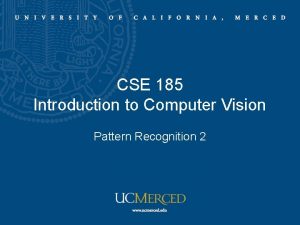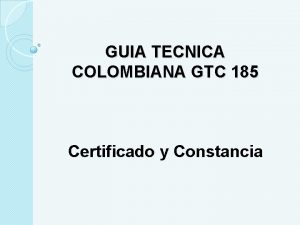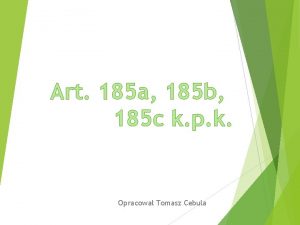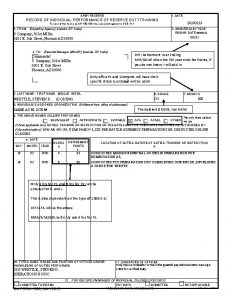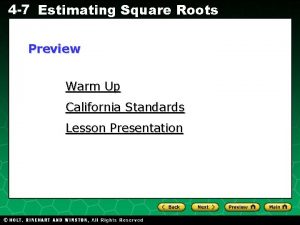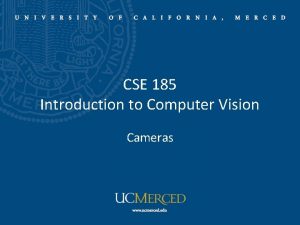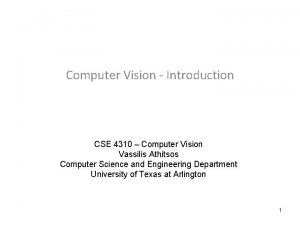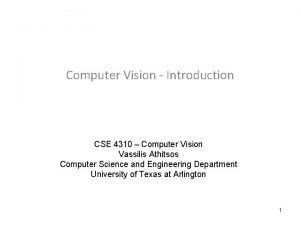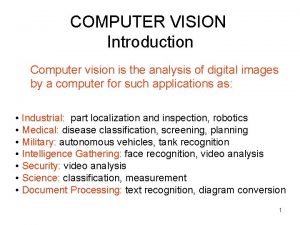CSE 185 Introduction to Computer Vision Light and



























- Slides: 27

CSE 185 Introduction to Computer Vision Light and color

Light and color • • Human eye Light Color Projection • Reading: Chapters 2, 6

Camera aperture f / 5. 6

The human eye • The human eye is a camera – Iris: colored annulus with radial muscles – Pupil: the hole (aperture) whose size is controlled by the iris – What’s the “film”? – photoreceptor cells (rods and cones) in the retina

Human eye Retina: thin, layered membrane with two types of photoreceptors • rods: very sensitive to light but poor spatial detail • cones: sensitive to spatial details but active at higher light level • generally called receptive field

Human vision system (HVS)

Exploiting HVS model • Flicker frequency of film and TV • Interlaced television • Image compression

JPEG compression Uncompressed 24 bit RGB bit map: 73, 242 pixels require 219, 726 bytes (excluding headers) Q=100 Compression ratio: 2. 6 Q=50 Compression ratio: 15 Q=10 Compression ratio: 46 Q=1 Compression ratio: 144 Q=25 Compression ratio: 23

Digital camera CCD • • • Low-noise images Consume more power More and higher quality pixels vs. CMOS • • More noise (sensor area is smaller) Consume much less power Popular in camera phones Getting better all the time http: //electronics. howstuffworks. com/digital-camera. htm

Color What colors do humans see? The colors of the visible light spectrum color wavelength intervalfrequency interval red ~ 700– 635 nm ~ 430– 480 THz green ~ 560– 490 nm ~ 540– 610 THz blue ~ 490– 450 nm ~ 610– 670 THz

Colors • Plot of all visible colors (Hue and saturation): • Color space: RGB, CIE LUV, CIE XYZ, CIE LAB, HSV, HSL, … • A color image can be represented by 3 image planes

Bayer pattern Color filter array • A practical way to record primary colors is to use color filter array • Single-chip image sensor: filter pattern is 50% G, 25% R, 25% B • Since each pixel is filtered to record only one color, various demosaicing algorithms can be used to interpolate a set of complete RGB for each point • Some high end video cameras have 3 CCD chips

Color camera Bayer mosaic color filter CCD prism-based color configuration

Demosaicing original reconstructed

Demosaicing • How can we compute an R, G, and B value for every pixel?

Grayscale image • Mainly dealing with intensity (luminance) • Usually 256 levels (1 byte per pixel): 0 (black) to 255 (white) (sometimes normalized between 0 and 1) • Several ways to convert color to grayscale Y=0. 2126 R+0. 7152 G+0. 0722 B

Recolor old photos http: //twistedsifter. com/2013/08/historic-black-white-photos-colorized/

Projection • Readings – Szeliski 2. 1

Projection • Readings – Szeliski 2. 1

Modeling projection • The coordinate system – – We will use the pin-hole model as an approximation Put the optical center (Center Of Projection) at the origin Put the image plane (Projection Plane) in front of the COP The camera looks down the negative z axis • we need this if we want right-handed-coordinates

Modeling projection • Projection equations – Compute intersection with PP of ray from (x, y, z) to COP – Derived using similar triangles (on board) • We get the projection by throwing out the last coordinate:

Homogeneous coordinates • Is this a linear transformation? • no—division by z is nonlinear Trick: add one more coordinate: homogeneous image coordinates homogeneous scene coordinates Converting from homogeneous coordinates

Perspective Projection • Projection is a matrix multiply using homogeneous coordinates: divide by third coordinate This is known as perspective projection • The matrix is the projection matrix

Perspective Projection • How does scaling the projection matrix change the transformation?

Orthographic projection • Special case of perspective projection – Distance from the COP to the PP is infinite Image World – Good approximation for telephoto optics – Also called “parallel projection”: (x, y, z) → (x, y) – What’s the projection matrix?

Variants of orthographic projection • Scaled orthographic – Also called “weak perspective” – Affine projection • Also called “paraperspective”

Camera parameters A camera is described by several parameters • • Translation T of the optical center from the origin of world coords Rotation R of the image plane focal length f, principle point (x’c, y’c), pixel size (sx, sy) yellow parameters are called extrinsics, red are intrinsics Projection equation • • The projection matrix models the cumulative effect of all parameters Useful to decompose into a series of operations identity matrix intrinsics • projection rotation translation The definitions of these parameters are not completely standardized – especially intrinsics—varies from one book to another
 Cse 185
Cse 185 Cse 185
Cse 185 Fft
Fft Cse 185
Cse 185 Cse 185
Cse 185 Cse 185
Cse 185 Cse 185
Cse 185 Cse 185
Cse 185 Cse 185
Cse 185 Cs766
Cs766 Light light light chapter 23
Light light light chapter 23 Light light light chapter 22
Light light light chapter 22 Light light light chapter 22
Light light light chapter 22 Genesis 28 lds
Genesis 28 lds Constancia
Constancia Cooking food in a liquid between 150-185 f
Cooking food in a liquid between 150-185 f Cooking food in a liquid between 150-185 f
Cooking food in a liquid between 150-185 f 185 c kpk
185 c kpk Lesson 2 slope page 185
Lesson 2 slope page 185 321 - 185
321 - 185 Da form 1380
Da form 1380 Evaluate 144/121
Evaluate 144/121 Huawei 185
Huawei 185 Ancient china map
Ancient china map Put out the light then put out the light
Put out the light then put out the light Leucoplast double membrane
Leucoplast double membrane It is the bouncing off of light
It is the bouncing off of light Computer vision: models, learning, and inference
Computer vision: models, learning, and inference








